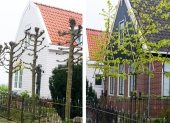
 3
3




 1
1








 1
1




Iterations are fine, we don't have to be perfect
My 2nd Location:Florida HardinessZone:10 AHS:10 GDD:8500 Rainfall:2in/mth winter, 8in/mth summer, Soil:Sand pH8 Flat
 3
3




sortof-almost-off-grid in South Africa: https://www.instagram.com/heartandsoilnoordhoek/




Jo Hunter-Adams wrote:I'm a little further from the ocean (2km) but we also get extremely strong winds (sometimes salty), have very sandy soil and also have a Mediterranean climate. What is your water situation like? If you have plentiful water (and time to water), growing from seed in situ may be ok, but growing in pots/bags may be better. I do grow from seeds and cuttings, but I grow in bags and then gradually harden things out.
I use relatively large, wind resistant trees/shrubs grown in bags very densely as a barrier/hedge/windbreak, then sell them or move them to a new area of cultivation when the tree is hardy enough to survive. Good windbreaks with relatively low water needs (and non-invasive) here include Cape Silver Oak (brachylaena discolor), some types of hibiscus (which I sell when it is no longer helpful/useful), our native fynbos (proteas etc-- which are hard to get started and don't like their roots being disturbed but form great windbreaks), and kei apples. Some acacias (and senegalensia) do well too. If you have a house on the site, I would suggest starting by planting where the house provides some wind protection, then work outwards (if necessary growing in bags close to house, then gradually moving the bags further away from wind protection). I have also used shade cloth/wire around trees, temporarily in places. In my experience it has been better to give as much attention as possible to trees in their first year, then taper off attention as they get more established/stronger.
I also use various types of pelagonia/geraniums around small trees as a small windbreak, as the tree grows it doesn't need the windbreak anymore, and has also outgrown the pelagonia, which stays small and doesn't mind wind. It's so easy to propagate many pelagonia from cuttings that I focus on quantity. Sometimes I'll also put trees/shrubs in bags around a tree as a windbreak, which also acts as a type of mulch to the tree I'm trying to protect. If I water the bags, extra water goes down to the tree.
I have not had much luck growing from seed and then leaving things alone, not even during winter rains. I have had success planting relatively large, hardy plants as a windbreak during winter or where I can water regularly for a week or two after planting-- and then leaving these alone to focus on edibles. Nowadays I'm able to grow many types of passiflora, grapes, pomegranate, almond, citrus, tamarillos bananas etc-- but they are all behind some level of windbreaks and all currently supported by watering. As my windbreak grows and my soil improves, I hope that the need for watering will decrease, but I am happy to water to help get the food forest established-- and happy to continue to water via drip irrigation if it means I get food.
 3
3





Moderator, Treatment Free Beekeepers group on Facebook.
https://www.facebook.com/groups/treatmentfreebeekeepers/





 1
1




Jd

|
This tiny ad's name is Bob. With just one "o".
Switching from electric heat to a rocket mass heater reduces your carbon footprint as much as parking 7 cars
http://woodheat.net
|


